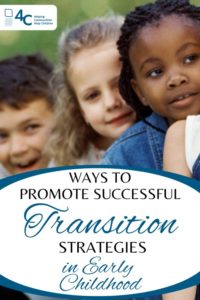August 2022 – Published by 4-C
There is no doubt that transitioning from one activity to another in early childhood classrooms can be challenging. Most parents, caregivers, family members, and teachers have experienced times when the children in their care have become upset when asked to switching between different activities. Here are some ways to help minimize associated frustrations with a bit of planning and flexibility.
For Parents, Families, and Caregivers:
Set Up and Stick to a Schedule
The way children respond to expected transitions is very different from how they react to unexpected ones. Throughout the day, maintain a schedule and refer to it when necessary. A visual schedule can aid in understanding and following a schedule, since language skills may affect them. It’s important to remember that transitions take time, even if everything goes smoothly. By setting aside that time in your schedule, you will be able to stay on track without feeling rushed or flustered.
Transition Cues
Using both verbal and nonverbal cues to signal to move on to a new activity will help minimize confusion. For example, instruments, songs, or even games are an effective strategy that encourages children to join in and will be more willing to prepare for the next activity.
Using Positivity
Children may not understand what is expected of them in the process of transitioning. Getting frustrated will only turn things into a worse situation for the children under your care and it is common for children to mirror your emotions. You can model appropriate behaviors and attitudes by remaining calm. Whenever children transition appropriately between activities, give them positive reinforcement. If you acknowledge desirable behaviors when you observe them, it is more likely you’ll receive desirable outcomes.
Using these strategies will reduce the chances of challenging behavior by helping children understand expectations.
For Educators
In order to best support parents and improve transitions, early childhood educators should study strategies they can share with parents on managing transitions at home by devoting time to developing strategies to share with parents on how to succeed. Consistency across the classroom and home environments can help promote successful transitions and minimize stress for both the children and those who care for them.
Work With Parents
It’s important for educators to partner and collaborate with parents to find methods that work. This can include teaching children a skill set they can practice with their parents that help them understand directions and move to a new activity. For example, parents can provide descriptive feedback on a child putting on a coat by themselves or brushing their teeth. Providing praise and/or feedback will help children learn cues to transition to something else.
Additionally, in order to help children express their feelings, encourage parents to teach them a variety of emotion words. Communication of desires and emotions can help children make difficult transitions easier.
Find A Balance of Activities
Physical activity and active play are so important for multiple reasons, including helping children make transitions. When developing a schedule, try to come up with activities that allow children to run around, exercise, and get all of their energy out. Additionally, towards the end of the day providing short, relaxing activities will allow them to easily transition to going home.
Individualized Strategies
There will still be times when transitions are challenging for some children despite preventive strategies. As early childhood educators learn about challenging situations, they can give parents individualized recommendations.
Support Parents
Educators should consider which strategies best meet parents’ unique needs. In addition to modeling for parents, educators should also plan for less stressful learning opportunities during which they can help parents solve problems together.
Collaboration between educators and parents is important in assisting children with transitions in early childhood. Teachers and parents should openly communicate about their struggles with transitions to determine the best possible solutions. Transitions can be difficult but with preparation and flexibility, you can minimize those challenges that will better prepare children and parents to be successful.
Is your child struggling with challenging behaviors while in child care? Is there a child in your classroom or program that could use additional behavioral supports?
4-C is partnering with Behavior Help Wisconsin to offer one-on-one coaching to child care providers and programs in Dane County. For more information check out this page.
Additional Resources:
- 4-C & Behavior Help Wisconsin
- 4-C: Transitioning to Child Care
- 4-C: Singing Through Transitions
- 4-C: Supporting Children in the Back-To-School Transition
- PBS: How to Prepare your Child for a New School
- Zero to Three: Challenging Behaviors
- 4-C Pinterest Board: Transitions


